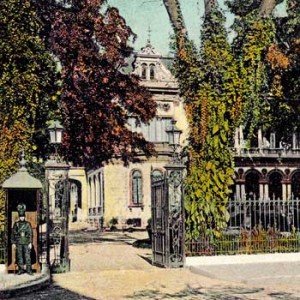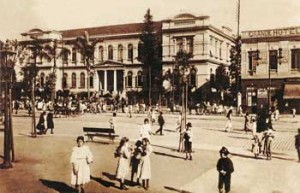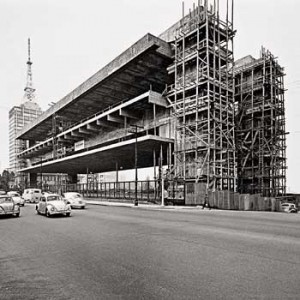
Reproductions from the book Lembranças de São Paulo/Gerodetti and CornejoPresident’s residence in Campos ElísiosReproductions from the book Lembranças de São Paulo/Gerodetti and Cornejo
“Little São Paulo seamstress/ Franco-Italic-Ibero-Saxon-Brazilian,/ I like your crepuscular ardor/ crepuscular and therefore more ardent, /pioneer-like!” wrote Mário de Andrade in Pauliceia desvairada [Hallucinated City], in which he passionately describes the new city and its “mouth with a thousand teeth” capable of swallowing and synthesizing all races and all classes in its structures. Even though it was not intentionally based on Andrade’s creed, a group of researchers from the School of Architecture and Urbanism (FAU) of the University of São Paulo (USP), the São Carlos School of Engineering, the Anthropology Department of FFLCH and the Paulista Museum came together in a theme project entitled “São Paulo: foreigners and the construction of the city,” backed by FAPESP and coordinated by Professor Ana Lúcia Duarte Lanna, from FAU, precisely to try to understand how foreigners shaped the structures of the metropolis. “To study the architectural and urban changes that have taken place since the late nineteenth century, the survey took as its guideline the foreign presence, which was fundamental for the city’s physical, demographic, economic, social and cultural transformation. However, foreigners were not merely reduced to immigrants, although the particular situation of immigration was addressed. Foreigners were taken into account in relation to the universe of work: that of free, blue collar and manufacturing-related work, as well as intellectual work, handicrafts, and the work of the self-employed, such as architects and intellectuals,” explains the researcher.
In addition to its theoretical research, the project will also result in a virtual collection, a database that will be available on the Internet, as all the archival material used in the research is to be digitized. Since a large part of this documentation is not properly clean and catalogued, which limits its use and even makes its dissemination unfeasible, the theme project is also to provide a solution for these research-limiting factors. The project is digitizing collections from the Paulista Museum, especially the Aguirra Collection, a precious archive of data on real property deeds, and other historical collections. For architects, however, the biggest tidbit will undoubtedly be the recovery of the collection of projects from the FAU-USP library, which includes the collected works of three of the biggest names of modernism in São Paulo (Jacques Pilon, Gregori Warchavchik and Giancarlo Palanti), to a total of 14,600 original drawings. Once they have been restored, catalogued and digitized, they will be available for consultation on the theme project’s web database. The group appears in the research when a new profile for the foreigner in São Paulo is discussed, in connection with the institutionalization of the profession of architecture that occurred between the 1920’s and the 1960’s, a period that coincides with the move to the city of new, urban and intellectual foreigners. It was a time when modern individuals dispersed all over the planet; a time when many of them arrived in Brazil, endowing the local scene with prestige while using it as a setting for clashes over worldwide modernism.
Foreigners, however, began to affect São Paulo long before this, obviously. The so-called Line 1 of the research deals with central districts (Bexiga, Bom Retiro, Campos Elísios) and the world of foreigners is that of the immigrants who did not get involved with coffee growing or with subsidized immigration and who made the city their first and foremost destination. “The districts selected formed part of a greenbelt of country houses, and they were chosen for the particularities of their constitution and for the ways in which foreigners were incorporated into the shaping of their territories,” explains Ana Lanna. Bexiga was confirmed as an Italian district when, between the late nineteenth century and the early 1920’s, the reference points linking the region with urban waste were eliminated, as were the marks and references to blacks, turning it into a poor, white European neighborhood in which immigrants and a certain middle class lived side by side.

Reproductions from the book Lembranças de São Paulo/Gerodetti and CornejoModel school in the district of BrásReproductions from the book Lembranças de São Paulo/Gerodetti and Cornejo
Bom Retiro
Bom Retiro is seen as a district characterized by being taken over by successive waves of foreigners between 1920 and 1940; despite the presence of major industries, it stands out from other manufacturing locations by having small family businesses, halfway between industry and commerce. The research, coordinated by Sarah Feldman, reveals how activities linked to the apparel industry and trade dispensed with demolition and were established in pre-existing physical structures. The work also showed that in the center where these activities were concentrated, what prevailed was the expansion and remodeling of the existing buildings, the original layout being maintained. There was also the highly organized Jewish community, which, as from the earliest days of immigration, set up a support network for its new-arrivals with the aid of those São Paulo Jews who had already become members of the industrial elite and of international organizations. According to the study, the success of this system has been repeated by the new Korean immigrants in the district, studied by Professor Maria Ruth Amaral de Sampaio.
The research on Campos Elísios, coordinated by Paulo Marins, shows that the standard of detached homes on the lots, although predominant, was limited by the restriction of the target audience prioritized by Victor Nothmann, a German who arrived in São Paulo in the 1860’s. The entrepreneur acquired a large tract of land in partnership with his fellow-countryman Friedrich Glette, who remained in Rio de Janeiro. Their plan was to create the “first district exclusively for the elite.” At first, the research led the professors to assume that, as a foreigner familiar with the expansion of European cities in the mid-nineteenth century, Nothmann had embraced the urban standards connected with class specialization and greater isolation of the homes on the lot, the determination of the target audience of the undertaking, and the coexistence of these standards with conventional alignment solutions. Thus, in the case of Campos Elísios, the focus of the study became the figure of the real estate entrepreneur, in this case Nothmann. “Currently, however, I no longer think that there was a plan for an exclusive, elite district in Campos Elísios, nor that there were a larger number of detached residences on the tract of land. I believe that there was an adaptation to the market, with a product being offered that, although far from the standards of elite Parisian neighborhoods, adopted some of their features, elitism being established only as far as possible and in a fragmentary manner,” says Ana Lanna.
The work of the researchers shows, however, the foreign presence back at the time when the country houses that were originally in the districts were divided up into smaller lots. Even before the sociability by which they were characterized or the identity of given ethnic groups had been established, foreigners were already agents for setting up their own territories. “In Bexiga, data reveal foreigners actively participating in dividing up large pieces of land into lots and promoting the construction of buildings by 1890. In Campos Elísios, on the other hand, foreigners acted simultaneously, in both dividing land up into smaller lots and buying it up, like Nothmann and Glette,” observes Ana. “So both in Bexiga and in Campos Elísios, there is evidence that it was possible for foreigners to become agents of their configurations differently. They operated when these areas were still just developments rather than actual neighborhoods.”
In Bom Retiro, as Sarah Feldman shows, the special cycle happened between 1920 and 1940, when Jews started buying properties in the area. “The transformations that took place were characterized less by the dominant logic of the city, supported by demolition/reconstruction, and more by successive appropriations of the same physical structure. What we had was the permanence of the urban tissue and the constant coming and going of immigrants,” Ana analyzes. The region specialized in and consolidated itself as an industrial and commercial center of ready-made apparel, which was closely linked to industry and structured to sell to the consumer. From 1928 to 1945, more than 300 establishments were set up in the district and those not belonging to Jews were fewer than a dozen.

Reproduction from the book Lina por escrito, edited by Rosana Rubino and Marina Grinover/Cosac Naify MASP under construction: the museum brought thinkers to the cityReproduction from the book Lina por escrito, edited by Rosana Rubino and Marina Grinover/Cosac Naify
During the 1940’s, when Bom Retiro was becoming consolidated, São Paulo city’s population was also becoming denser, giving rise to a new type of mass society well suited to a means of communication hitherto non-existent among the city’s inhabitants. This is what the so-called Line 2 of the research focuses on: the transformation of professional fields, their practices, networks and players, and the circulation of knowledge. In other words, this is when the world of foreigners became characterized by people moving from city to city, because of their more professional and intellectual profile and because of their distinguished role in their various professional fields. With the proposal of creating the São Paulo Art Museum (Masp), directed by Italian journalist Pietro Maria Bardi, there arose the opportunity for a group of Italian intellectuals – Lina Bo Bardi, Roberto Sambonet, Gastone Novelli and Leopold Haar (the group’s only non-Italian) – who lived on the Milan-Rome circuit between the wars, to come to São Paulo and take part in debates on the architecture and culture of the period, “They brought European experience to areas little explored by the people of São Paulo, such as the design of furniture, the production of posters, the layout of magazines and newspapers, the design of stands for exhibitions, window-dressing, etc. Thus, in 1951, the Institute of Contemporary Art (IAC) began to function alongside MASP. Its purpose was to train professionals to work in the fields of industrial design, the graphic arts and visual communication, thus strengthening the debate about construction trends in São Paulo.” The intention of the IAC, which worked like a “native Brazilian Bauhaus” experiment, was to get closer to São Paulo’s industry to supply it with projects, since the Italians’ assessment was that supreme bad taste reigned in the coffee metropolis. At the same time, São Paulo was the stage for important visits by several foreign architects and intellectuals who either visited the capital or who settled in it, such as Richard Neutra, Bernard Rudofsky or Gregori Warchavchik (analyzed in the study by José Lira), who contributed to urban transformation and the city’s inclusion in international circuits.
Rockefeller
In 1945, the year in which Masp was inaugurated, within the post-war context and with the re-establishment of democratic ideals, urban planning also took on new political airs, as revealed in the work of Cristina Leme. On July 14, 1950, a contract was signed by the São Paulo city council, represented by mayor Lineu Prestes, and IBEC/International Basic Economy Corporation, owned by US businessman Nelson Rockefeller. The idea was to prepare a Public Improvement Plan for São Paulo, to be coordinated by the famous Robert Moses, who had been responsible for the controversial urbanism of New York. “From the urban point of view the program can be seen as a continuation of the plan of the Prestes Maia Avenue of 1930, emphasizing yet again a system of expressways as the solution for road transport. Controversial and criticized by urbanists and architects alike, the program did not take into account the studies carried out at that time for building an underground or surface rail system,” observes the researcher. Two issues that the program addressed, namely, the purchase of buses for public transport and the proposal of a corporation with the participation of the Light Tramway and Power company (with which Ibec had already established a prior partnership in another project) for urbanizing the land along the Pinheiros River, gave rise to the possibility of establishing an arena for business between foreign and Brazilian entrepreneurs and the city administration. Henrique Dumont Villares, who had already tried to extort bribes from Henry Ford in the latter’s venture to extract rubber at Fordlândia, in the Amazon Region (see Pesquisa FAPESP nº 158), was once again involved in nebulous negotiations as a go-between.
“It’s precisely the dissimilarity of input and experiences, as well as the marks that these various foreigners left on the city, and their images and reflections of it, that this project plans to capture and analyze,” adds Ana Lanna. “Let us bedeck ourselves with coffee-berry garlands!/ Tarata! and the chant of derision to the world!/ Oh! what great pride exists in the manner of São Paulo!!!” was how Mário de Andrade joked about this São Paulo style.
Republish